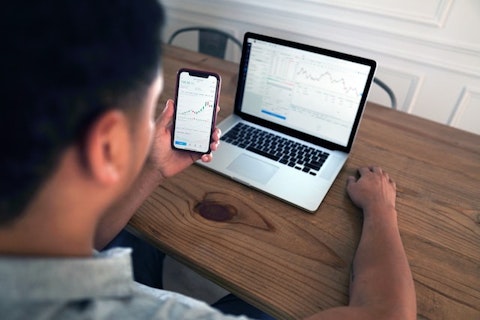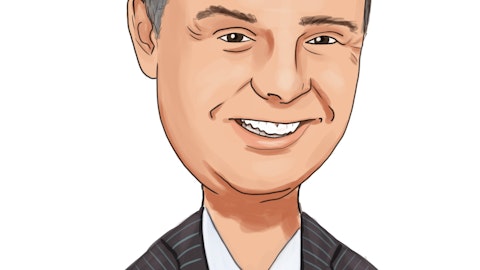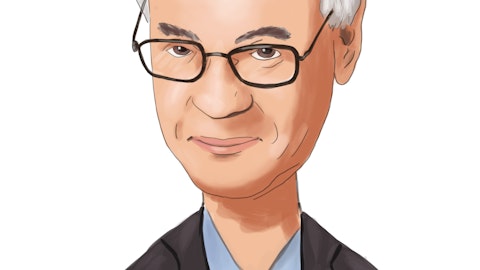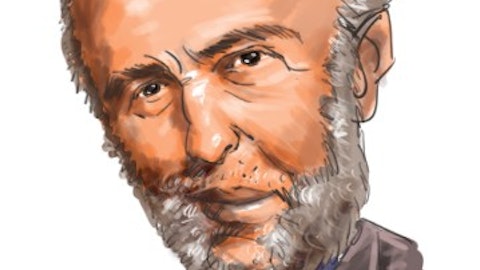Business First Bancshares, Inc. (NASDAQ:BFST) Q4 2022 Earnings Call Transcript January 26, 2023
Operator: Thank you for standing by, and welcome to the Business First Bancshares Q4 2022 Earnings Call. It is now my pleasure to turn the conference over to Matthew Sealy, SVP, Director of Corporate Strategy and FP&A. Mr. Sealy, please go ahead.
Matthew Sealy: Thank you. Good morning, thank you all for joining. Yesterday afternoon, we issued our fourth quarter 2022 earnings press release, a copy of which is available on our website, along with the slide presentation that we will refer to during today’s call. Please refer to Slide 3 of our presentation, which includes our safe harbor statements regarding forward-looking statements, and use of non-GAAP financial measures. For those of you joining by phone, please note the slide presentation is available on our website at www.b1bank.com. Please also note that our safe harbor statements are available on Page 7 of our earnings press release that we have filed with the SEC yesterday. All comments made during today’s call are subject to the safe harbor statements in our slide presentation and earnings release.
I’m joined this morning by Business First Bancshares President and CEO, Jude Melville, Chief Financial Officer, Greg Robertson and Chief Banking Officer, Philip Jordan. After the presentation, we’ll be happy to address any questions you may have. And with that, I’ll turn the call over to you Jude.
Jude Melville: Allright, thanks Matt. And thanks everybody for joining us this morning. We know you have choices about where to be, and we appreciate you deciding to prioritize being here with us. We’ll, I’ll keep the remarks kind of brief. So we can jump into questions, I do want to go over some of the notable trends from the quarter and then some four year highlights. And then we’ll get into the Q&A. Fourth quarter, successful fourth quarter we were pleased with, with where we ended the year of non-GAAP core net income of $16.4 and $0.66 per share available to common holders better than we expected and for good positive reasons. Primarily, primarily, we continue to have good strong loan growth and almost 16% annualized, and one of the things that I was excited about was to see if that was diversified.
We had it across our regions. And then also a good balance between commercial and CRE credits as well. Second, kind of positive impacts the numbers was we had higher loan accretion than we expected. We were able to, to, to sell a couple of loans that we felt it’s good timing for us. And then we had a large payoff as well, so — and those loans had accounting marks related to them that were able to benefit from it. We benefited slightly from non-interest income through SBIC revenue. And you’ll remember that we have a number of investments in SBIC’s, which occasionally surprised on the upside, and this was one of the quarters in which we had about 400,000 above budgeted SBIC income. We continue to focus on efficiencies. So we’re proud of the fact that that our non-interest expense came in just below expectations.

Photo by Joshua Mayo on Unsplash
So certainly, given the environment that we’re in being able to, to have discipline on expenses is important. Even though we were able to keep our expenses lower than we anticipated, we also made a number of key hires, including Jerry Vascocu, who joined us as our Chief Administrative Officer. After 17, 18 years at Iberia and First Horizons and we’re sort of excited to A, have the contribution of the experience that he’s had, being a part of growth organizations and certainly the contact base, but also excited that it goes out our executive teams. So we felt like we’re well established for where we need to be from the senior leadership perspective over the next few years, as we begin to approach the $10 billion mark in assets. We did have an elevated loan loss provision relative to our expectations.
We took two specific reserves on loans. And we can talk more about that in the Q&A. But both we certainly consider them to be isolated and one-off incidents, one of which involve fraud. And so we don’t feel like that’s representative of anything more systemic across the portfolio. And our overall credit metrics certainly reflect that. So if you adjust the quarterly results for the backing out the additional loan discount accretion and the higher loan loss provision, we would have had about $15.4 million for the fourth quarter, which is still slightly ahead of expectations. So we feel very positive about that. Also, although it’s a challenge, and probably the challenge going forward over the next two or three quarters, we actually were not pleased with our performance on the NIM side of the ledger.
We did drop down 13 basis points on our core NIM. But you’ll remember in our last quarter, we talked about the fact that our third quarter was artificially inflated by about five basis points, and we expected to have five or six basis points drop modeled on top of that. So we came in really close to what we’ve modeled and we feel good about our modeling going forward. We feel like we’ll do well for say that or two. So I think it’s important to take a step back. It’s not just quarter to quarter, but first half of the year versus second half of the year, we had a 20 basis point increase in margin, even with that drop and so we feel like we’re, we’re in a better place going into next year or this year. I guess we are now versus where we were next year.
We’ve also thought the fourth quarter was a little bit of a catch-up phase and we’ve modelled that where we had kind of held off on some, some great moves, and we’re kind of catching up. And we feel like we’ll be able to stay about flat for this quarter and then have some slight increases over the rest of the year. So we’ll talk a little more about that when we hit the Q&A but, but not I’m pleased with where we are, from a margin perspective. Taking a step back and looking at the full year and review, it was a record year in many ways for us. We achieved a record quarter net income of $57.6 million for the year, which was about 10% above what we finished last year. But last year, you’ll remember included a sizable positive impact of selling our PPP portfolio so we actually generated significantly more income this year and feel well poised to take on 2023 with some of the some of the nonmonetary accomplishments that we had over the course of the year which includes integrating the Texas Citizens transaction out of Houston.
It includes integrating a number of banking teams that we picked up at the beginning of the year. So those are, those are kind of like mini acquisitions in a way and they take effort and, and judgment and time and so feel really good about the success that they’re having. And don’t feel that they are yet at capacity. So we should continue to see good things coming from those teams. We also opened our fourth full service locations in Uptown Dallas and, and experienced a lot of activity they’re excited about. We actually crossed over a billion dollars in loans in Dallas, this past quarter and when you combine the Dallas and Houston operations, we’re at about 35% of our credit portfolio as a whole is in those two large and fast growing metro areas.
So as we have talked about one of our goals is getting closer to 50% of our exposure outside of Louisiana’s so we can be diversified. And we took really big steps towards that this year. And finally, I would just say that we feel good about fortifying our balance sheet. We raised 122 million in equity over the second half of 2022. 72 million in a self-managed preferred equity race, which this quarter was our first quarter to, to pay the dividend on that preferred equity raise which to be able to pay that dividend without yet putting in all the work can still be at our numbers. It’s something that I feel is another positive. And then we also did a $50 million common equity raise. So we feel well placed to take on the opportunities that we feel are out there in this next year.
Our clients remain highly positive and incompetent. Certainly there will be some challenges but all in all with the strongest asset quality that we’ve had and our four or five balance sheet, and then a stronger team than we’ve ever had, we feel well positioned to take on 2023. So appreciate your time and happy to answer any questions you might have.
Operator: Feddie Strickland with Janney Montgomery Scott, your line is open.
Feddie Strickland: Hey, good morning, everybody.
See also 10 Countries with the Largest Nickel Reserves and 10 Cash Rich Stocks To Buy.
Q&A Session
Follow Business First Bancshares Inc. (NASDAQ:BFST)
Follow Business First Bancshares Inc. (NASDAQ:BFST)
Jude Melville: Hey Feddie.
Feddie Strickland: So it was pretty impressive you guys were able to replace FHLB borrowings with deposits in this environment. Do you think you’ll need to return to the FHLB later in the year? Or do you feel like there’s enough deposit opportunities out there that you can kind of avoid wholesale funding for the near future.
Jude Melville: Well, I think one of the reasons that we maintain access to the line is so that we can have it as backup. We certainly would prefer to do the core funding raise and we feel we have some good activity and had some success in the fourth quarter and we certainly feel like first quarter will be even stronger perhaps in the fourth quarter. And over the course of the remainder of the year, we certainly would prefer to do core deposits. But one reason we paid down the line is because we want to make sure that we maintain access to that secondary source of liquidity. So hopefully, we don’t have to use it, but if the opportunities make sense for us from a growth perspective to fund them through the FHLB and we certainly would utilize them if it made sense. So we’re going to try not to. But if we do, we do, I guess, but it was nice to have enough tools in the tool belt as we navigate over the next year.
Feddie Strickland: Got it. That makes sense. And then just kind of more broadly on the margin, what should we expect from here? It came in a little better than we were expecting this quarter, part of that — it sounds like it was related to a loan accretion income. But can we just talk through kind of where — I think the core margin was 375 if I remember correctly. Can you talk about where you see that going from here? I mean, it’s been good to see the yields come up and the loan beta outpace the deposit beta. But just — I guess I’m wondering, does that continue from here?
Jude Melville: Great. I’ll let Greg talk in detail about the margin.
Gregory Robertson: Yes. Thanks, Feddie. I think what gives us an optimistic outlook is — if you look at the margin kind of month by month in the quarter, we started out margin in October at $3.71 and November, we moved it to $3.72, in December, $3.83. So we had some pickup in the margin within the quarter, really driven by the top line loan yields that we were able to manage through. So just to put that in context, September loan yields were 16 around new loans. And then the December new loan origination yields were 7 62. So we continue to update our pricing model every week. We manage that process. We feel like, as Jude mentioned a little bit earlier, we were a little aggressive on moving up our deposit rates late third quarter, early fourth quarter to position ourselves to be able to generate some of those deposits and increase core funding.
We think that’s going to continue, and we also think we’ll be able to push those loan deals forward. What we’re thinking in the first quarter is flat to maybe up 1 basis point or 2 on the margin. And then as the year goes on, maybe up 5 to 7 basis points each quarter thereafter. So we’re going to continue with the pricing model the way we have it and manage it that way.
Feddie Strickland: Got it. And is the 5% to 7% each quarter; is that on the core of the GAAP margin or both?
Gregory Robertson: That would be on the core.



